With approximately 40,000 active duty service members, the U.S. Coast Guard is by far the smallest of the military branches and is the only branch outside the Department of Defense. Since 2016, missing data have precluded analysis of USCG health care data from the MSMR’s annual burden reports.1,2 A recent analysis demonstrated a USCG hospitalization rate 40% lower than DOD active component counterparts, indicating that concerns raised in 2016 about incomplete capture of USCG medical record data have not been completely addressed. Until these data issues can be resolved, a separate analysis of USCG burden is warranted.
The USCG operates primary care clinics in areas with sufficiently large Coast Guard populations. Although USCG personnel are eligible to use DOD health care facilities, many are not stationed near any DOD installation. A higher proportion of civilian hospitalizations among USCG members has been noted,1 and this difference may extend to ambulatory care as well.
This summary uses the same disease classification system and health care burden measures as employed in the initial burden analysis to quantify the impacts of various illnesses and injuries among members of the active component of the USCG in 2022.
What are the new findings?
Among active component Coast Guard members in 2022, injuries, musculoskeletal diseases, and mental health disorders were the categories of medical conditions associated with the most medical encounters, the largest number of affected service members, and the greatest number of hospital days. COVID-19 accounted for 1.4% of total medical encounters and 0.7% of total hospital bed days.
What is the impact on readiness and force health protection?
Loss of duty availability because of illness and injury degrades personnel readiness. Coast Guard members have unique occupational exposures that may benefit from specific risk-reduction programs to mitigate these threats. Complete hospitalization data is critical to accurately estimate the medical burden among Coast Guard members. Efforts to ensure data completeness should be prioritized.
Methods
The population for this analysis includes all individuals who served in the active component of the USCG at any time during the surveillance period of January 1, 2022 through December 31, 2022. The methodology for summarizing absolute and relative USCG morbidity burdens in 2022 is identical to that used in the absolute and relative burdens attributed to various illnesses and injuries among the active component of the U.S. Armed Forces. This is the first year that DMSS data were housed and analyzed from the Military Health System Information Platform. Data quality assessments for completeness and timeliness are ongoing during the MIP transition, and data presented in this report are considered provisional but current as of March 21, 2023.
Results
In 2022, a total of 34,506 USCG service members experienced 390,665 total medical encounters. There were 8,717 bed days reported, for a rate of 0.22 bed days per USCG member who had at least one medical encounter (in- or out-patient).3
Morbidity burden, by category
In 2022, more active component USCG members (individuals affected; n=14,737) had medical encounters for injury than any other morbidity-related category (Figure 1a).
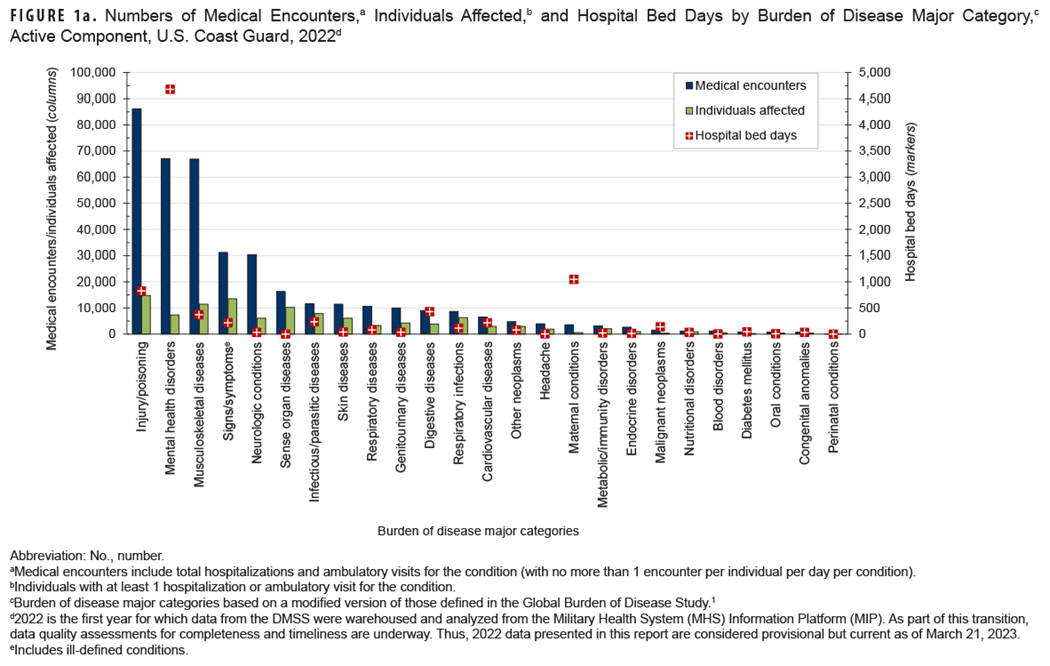
Ranking third in terms of hospital bed days, this morbidity category accounted for over one-fifth (22.0%) of all medical encounters (Figure 1b).
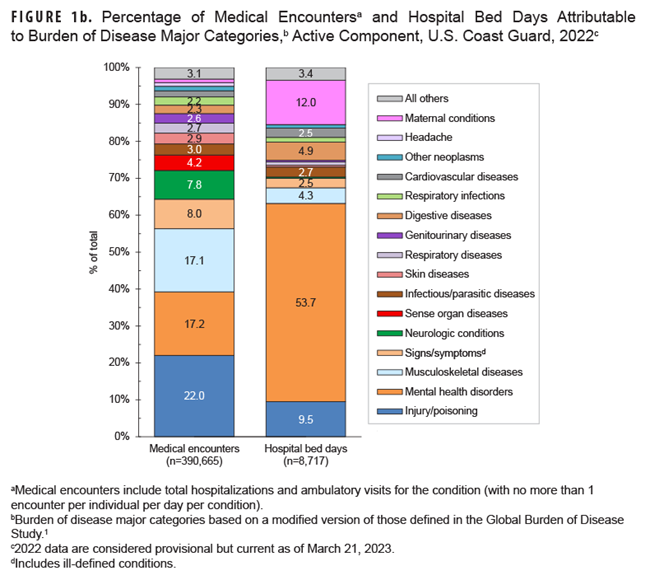
Mental health disorders accounted for more hospital bed days (n=4,680) than any other morbidity-related category, contributing over half (57.7%) of all hospital bed days and ranking sixth for number of individuals affected (Figures 1a, 1b). Together, injury and mental health disorders accounted for over three-fifths (63.2%) of all hospital bed days and almost two-fifths (39.2%) of all medical encounters.
Maternal conditions, e.g., pregnancy complications and delivery, accounted for a relatively large proportion of all hospital bed days (n=1,047; 12.0%) but a much smaller proportion of total medical encounters (n=3,626; 0.9%) (Figures 1a, 1b). Maternal conditions were the most prevalent medical condition among active component female USCG members. Women comprised approximately one-sixth (16.0%) of the active duty USCG in 2022.3
Medical encounters, by condition
In 2022, five burden of disease-related conditions accounted for more than one-third (35.0%) of all illness- and injury-related medical encounters: other back problems e.g., low back pain, other dorsalgia; arm/shoulder injuries; organic sleep disorders (e.g., obstructive sleep apnea, insomnia); anxiety disorders; and knee injuries (Figure 2). Moreover, the 10 conditions associated with the most medical encounters constituted more than half (56.0%) of all illness- and injury-related medical encounters.
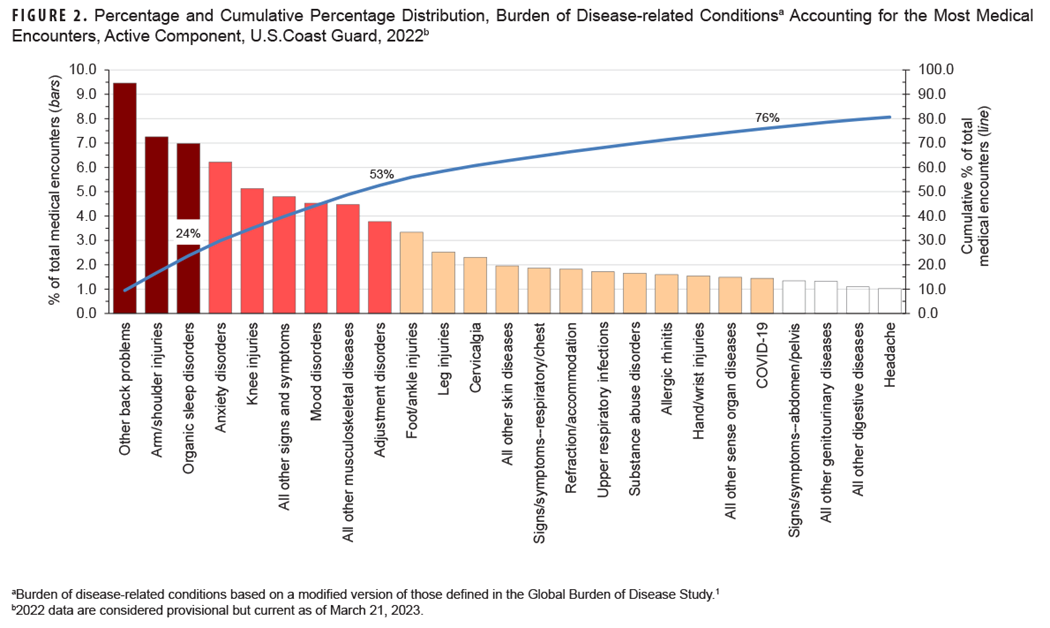
The conditions that accounted for the most medical encounters among active component USCG members in 2022 were predominantly injuries, mental health disorders, and musculoskeletal diseases. Among injuries, arm/shoulder (7.3%), knee (5.1%), foot/ankle (3.3%), and leg (2.5%) contributed the most medical encounters (Figure 2, Table [bottom of the page]). Anxiety (6.2%), mood (4.5%), adjustment (3.8%), and alcohol/substance abuse disorders (1.7%) were the four most frequent mental health disorder diagnoses. Of the musculoskeletal diseases, other back problems (9.5%), all other musculoskeletal diseases (4.5%), e.g., muscle weakness, radiculopathy of the cervical region, pain in foot, and neck pain (2.3%) contributed the most medical encounters. COVID-19 accounted for 1.4% of total medical encounters during 2022.
Individuals affected, by condition
The 10 conditions that affected the most USCG members in 2022 were all other signs and symptoms and respiratory/chest; other back problems and all other musculoskeletal diseases; refraction/accommodation disorders; organic sleep disorders; COVID-19 and upper respiratory infections; arm/shoulder injuries; and all other skin diseases. COVID-19 affected 4,546 USCG members and ranked seventh for the number of individuals affected.
Hospital bed days, by condition
In 2022, substance abuse and mood disorders accounted for about two-fifths (40.7%) of all hospital bed days (Figure 3).

Together, four mental health disorders (substance abuse, mood, anxiety, and adjustment) and two maternal conditions (pregnancy complications and delivery) accounted for three-fifths (60.3%) of all hospital bed days (Table, Figure 3). About 10% of all hospital bed days were attributable to injuries and poisonings. COVID-19 accounted for 0.7% of total hospital bed days among active component USCG members (Table).
Discussion
The USCG’s health care use in 2022 is similar to the DOD when measured by total encounters/persons affected. The USGC rate was 11.3 encounters per person (390,665 / 34,506), compared to the DOD rate of 10.7 encounters per person (11,874,264 / 1,108,975). The USCG had a lower rate of hospital utilization, however, with only 0.25 bed days per individual reporting a medical encounter; the DOD reported 0.33 bed days per individual (369,097 / 1,108,975). This finding is consistent with prior reporting and raises concerns that the missing data issues discovered in 2016 have not yet been fully resolved.4
This report is consistent with the major findings of prior annual reports on morbidity and health care burdens among active component members. Injuries, musculoskeletal diseases, and mental health disorders are the categories of medical conditions associated with the most medical encounters, the largest number of affected service members, and the greatest number of hospital bed days. USCG and DOD service members shared many disease-related conditions when examining ICD codes to the fourth digit character: other back problems within the musculoskeletal disease major diagnostic category; arm/shoulder and knee injuries within the injury major diagnostic category; anxiety disorders within the mental health disorder major diagnostic category; and organic sleep disorders within the neurologic condition major diagnostic category. The data presented in this report are considered provisional, as ongoing investigations for data completeness in the MHS MIP may result in later updates to the patterns of morbidity and health care burden reported here.
Although 2022 was affected by the COVID-19 pandemic, COVID-19 accounted for relatively modest numbers of medical encounters and bed days compared to other conditions included in this analysis, likely due to several factors. Besides the waning of the pandemic, active component service members represent a relatively young and healthy population less likely to experience severe consequences of COVID-19 infection. Notably, COVID-19 accounted for the most medical encounters but not bed days within the infectious and parasitic disease major diagnostic category. This finding was consistent with DOD service members.
Consistent with past analyses, this report documents that relatively few illnesses and injuries account for a substantial proportion of morbidity and health care burdens that affect USCG active component service members. Preventable illnesses and injuries that disproportionately contribute to morbidity and health care burdens should be high-priority targets for intervention, research, and resources. Opportunities to address and resolve the missing data issues from USCG hospitalizations should be prioritized to ensure an accurate depiction of the true burden of disease among this population.
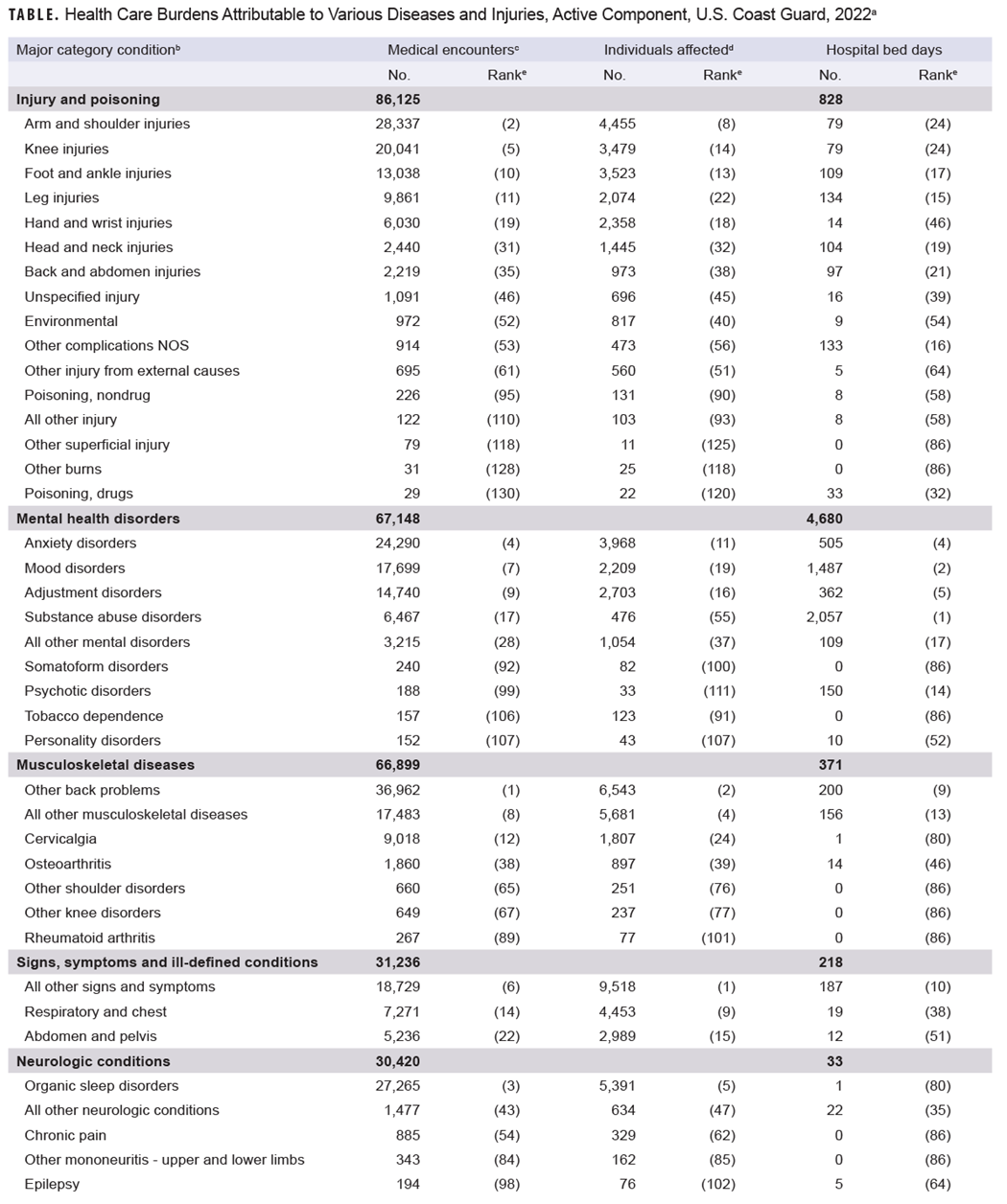

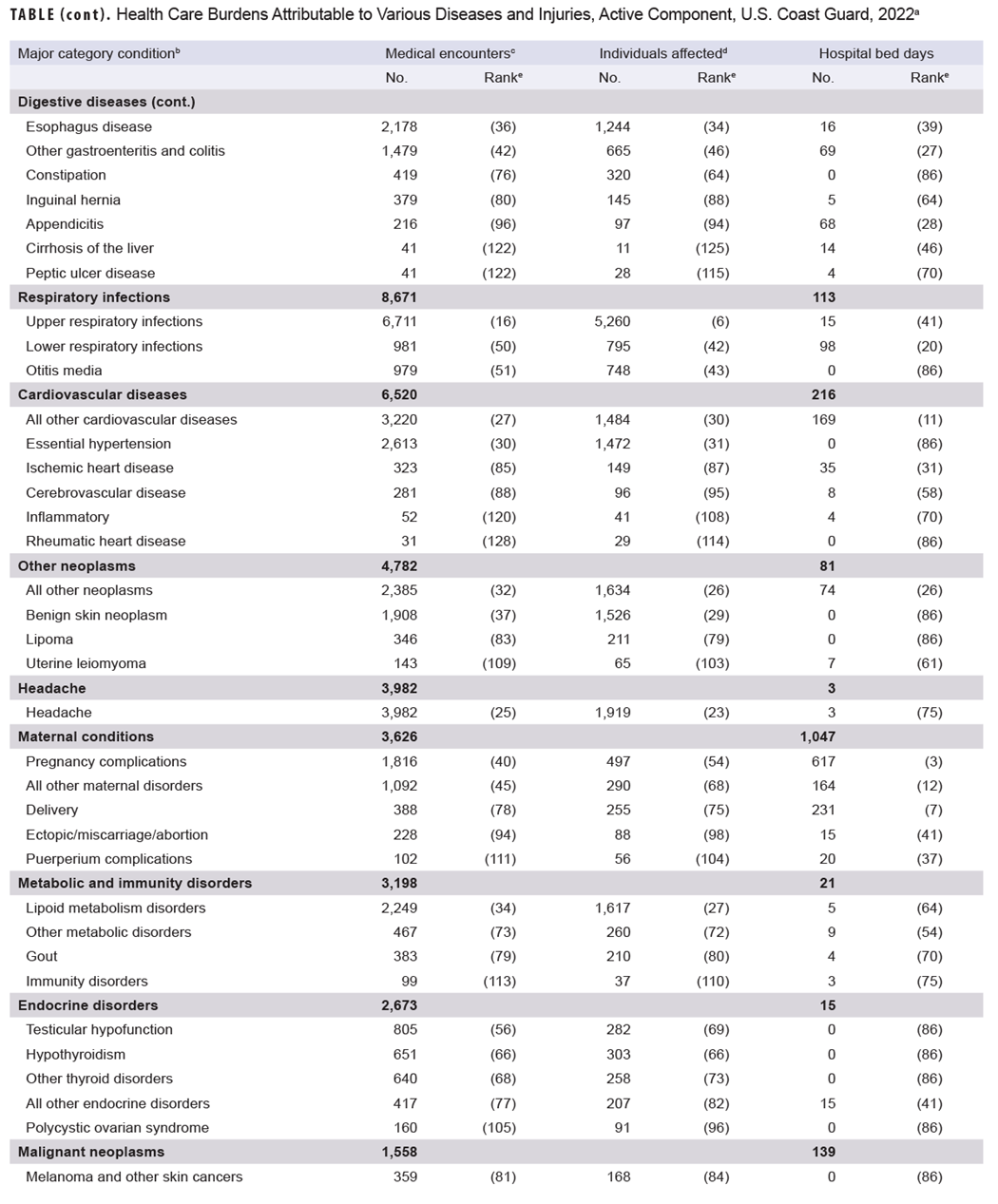
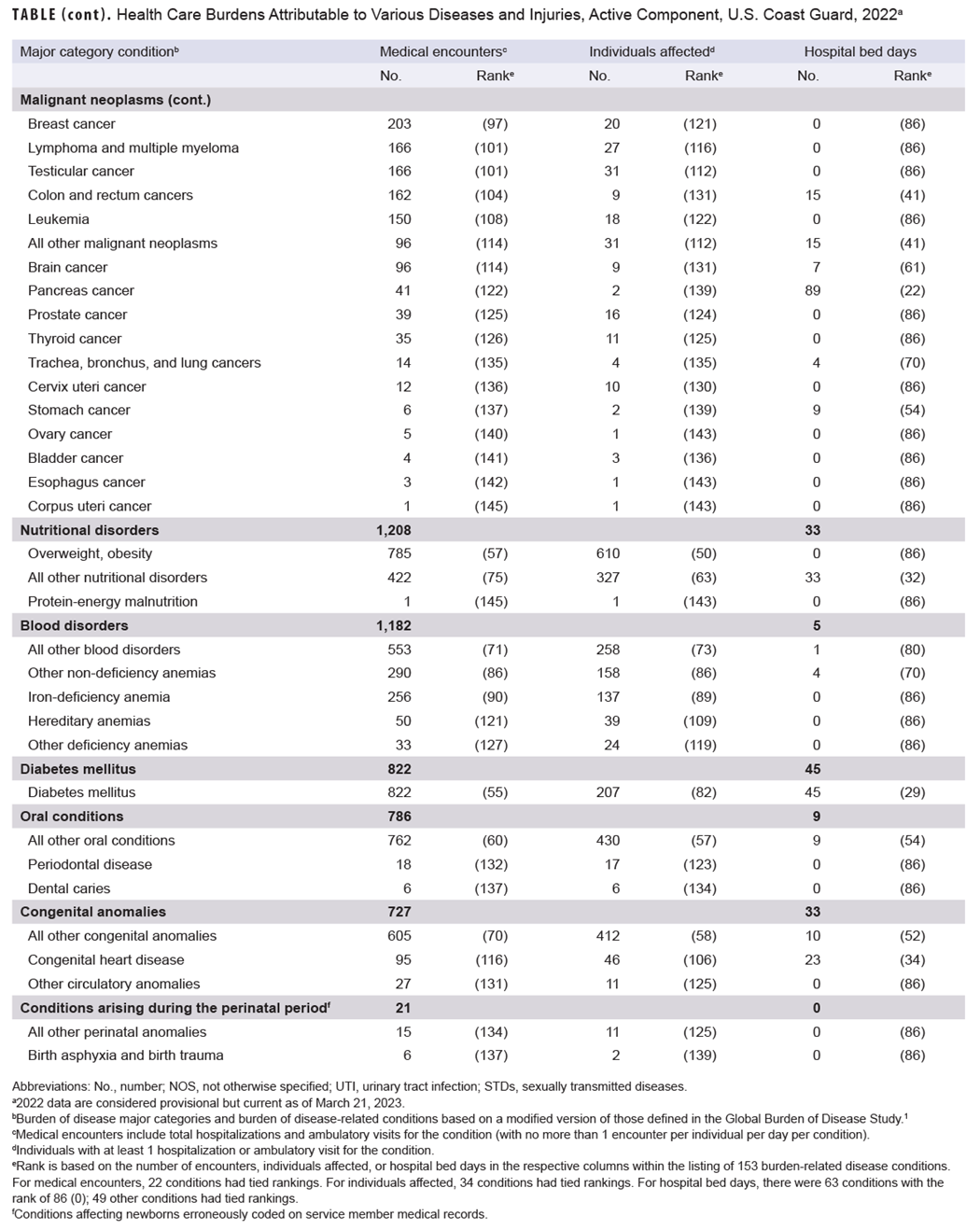
References
- Pillai S, Chau M, Kamara I, Thomas D, Iskander J. Hospitalizations among active duty members of the U.S. Coast Guard, Fiscal Year 2021. MSMR. 2023;30(2):3-5.
- Armed Forces Health Surveillance Branch. Hospitalizations among members of the active component, U.S. Armed Forces, 2015. MSMR. 2016;23(4):8-16.
- Defense Manpower Data Center. Self-service reports, Active duty by demographics, service branch. Accessed June 15, 2023. https://dmdcrs.dmdc.osd.mil/dmdcrs/public